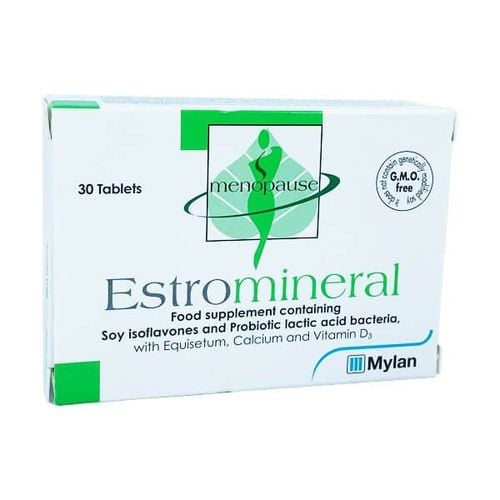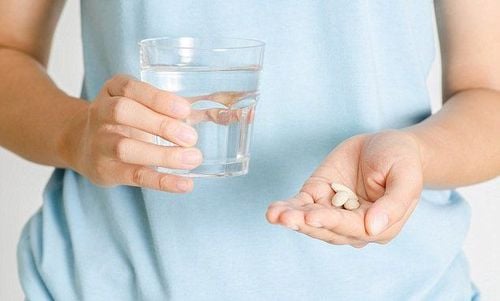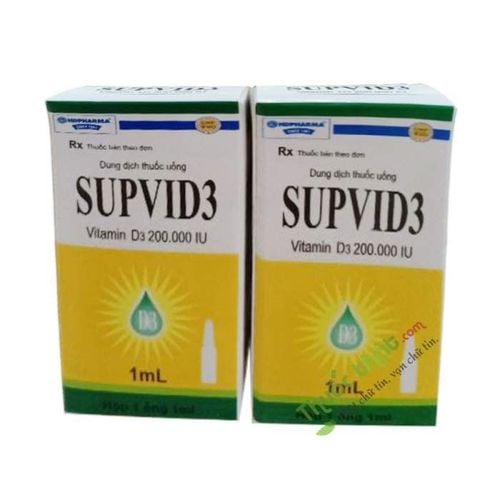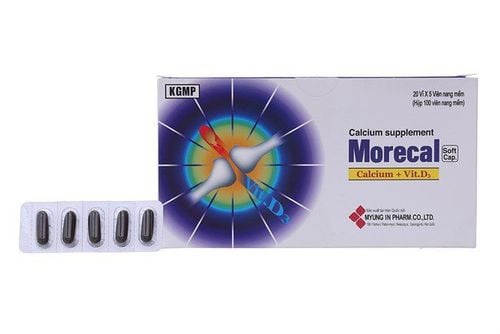This is an automatically translated article.
Posted by Pharmacist Nguyen Thi Bich Phuong - Clinical Pharmacist - Faculty of Pharmacy - Vinmec Ha Long International Hospital
Aquadetrim has the active ingredient cholecalciferol (Vitamin D3) which is the natural form of vitamin D found in animals and humans. For the effective use of the drug, users need to strictly follow the instructions of the doctor or pharmacist.
1. Ingredients and uses of Aquadetrim
Aquadetrim has the active ingredient cholecalciferol (Vitamin D3) which is the natural form of vitamin D found in animals and humans. The most important function of vitamin D is that together with parathyroid hormone and calcitonin regulate the metabolism of calcium and phosphate. Accordingly, vitamin D3 is a potent anti-rickets component, essential for parathyroid function. Aquadetrim plays a major role in absorbing calcium and phosphate from the intestinal tract, transporting mineral salts, participating in bone calcification, and regulating the amount of calcium and phosphate excreted by the kidneys.
Vitamin D deficiency is related to diet, absorption disorders, calcium deficiency, liver disease and certain medications,... Accordingly, the lack of exposure and sunlight will lead to disease rickets during rapid growth in children and osteoporosis in adults.
2. Indications for the use of Aquadetrim
Aquadetrim is indicated in the following cases:
Prevention and treatment of rickets and osteoporosis in children and adults. Prevention of rickets in premature infants. Prevention of vitamin D deficiency in children and adults with malabsorption. Treatment of hypoparathyroidism in adults. Each 1 ml of Aquadetrim contains 15000 units Cholecalciferol (Vitamin D3). 1ml Aquadetrim corresponds to 30 drops. Therefore, 1 drop corresponds to about 500 units of Vitamin D3.

Thuốc Aquadetrim có thể dùng cho trẻ nhỏ bị còi xương
3. Dosage, time of use, how to use Aquadetrim
Based on the individual's diet and location, the recommended dosage is as follows:
Prevention of deficiency: Children from birth and adults: 500 units (1 drop) per day. Treatment of deficiency: Depends on the degree of deficiency of each patient as indicated by the doctor. Vitamin D-dependent rickets: 3,000 to 10,000 units (6 to 20 drops)/day. Osteoporosis caused by anticonvulsants: Children: 1,000 units (2 drops)/day and adults: 1,000 units to 4,000 units (2-8 drops)/day Duration of treatment:
Prevention of scurvy Bones: Newborns and infants receive Aquadetrim from the second week of life until the end of one year. From the age of two, additional doses of Aquadetrim are required, especially during the winter months. Treatment of rickets and osteoporosis: 6 weeks, then a prophylactic dose (Do not continue the treatment dose for 1 year in a row due to possible vitamin D toxicity). Other indications will depend on the course of the disease and follow the doctor's orders.
Usage is as follows: Aquadetrim is taken with water, one drop corresponds to 500 units. Tilt the vial 45 degrees to accurately measure the dose.
4. Some cases should not take the drug and the note when using
Aquadetrim drug should not be used for the following subjects:
Hypersensitivity to any ingredient of the drug. Excess vitamin D, increased blood and urine calcium levels, renal calcium stones, severe renal failure, pseudohypoparathyroidism. Rare hereditary fructose intolerance, glucose-galactose malabsorption or saccharase-isomaltase deficiency. Care should be taken when using the drug in the following subjects:
Patient is immobilized. Are taking thiazide diuretics, cardiac glycosides. People with kidney stones, heart disease. Patients with sarcoidosis due to possible increased metabolism of active vitamin D. Newborns have small anterior fontanels. Patients with hyperparathyroidism need to consult a doctor. The drug contains excipients benzyl alcohol, macrogolglycerol can cause allergies. Especially for pregnant women, the recommended daily dose for pregnant women is 500 units; however, in women with vitamin D deficiency, a higher dose may be recommended. Pregnant women should follow the doctor's instructions. Avoid overdosage of vitamin D during pregnancy, as hypercalcemia can lead to physical and mental retardation such as aortic and retinal stenosis in the infant.
For women who are breastfeeding, vitamin D can be prescribed if necessary, but vitamin D supplementation in nursing women does not replace vitamin D supplementation in breastfed infants. Therefore, it is necessary to balance and calculate the amount of vitamin D supplement. In addition, users need to monitor calcium levels, blood phosphate and urinary calcium periodically during the use of the drug.

Thuốc Aquadetrim cần được kê đơn bởi bác sĩ chuyên khoa
5. Aquadetrim side effects
In fact, with the recommended dose of Aquadetrim, no side effects have been recorded. In rare cases of hypersensitivity to vitamin D3 or when excessively high doses are taken for a long time, vitamin D toxicity can occur. Symptoms of poisoning include:
Arrhythmia Headache, coma Conjunctivitis, photophobia Anorexia, nausea, vomiting, constipation Urea, polyuria, kidney stones Myalgia, joints, myasthenia. Hypercalcemia, urinary calcium, hypercholesterolemia, weight loss, increased sweating, pancreatitis. Increased blood pressure Increased activity of aminotransferase enzymes Urticaria, rash, itching Decreased libido, depression, mental disorders Some other undesirable effects may occur such as: Runny nose, increased body temperature, dry mouth, tissue calcification.
To ensure effectiveness, users need to use Aquadetrim exactly as prescribed by a doctor or pharmacist. In case of serious side effects, patients need to stop taking the drug and go to medical centers for advice from qualified doctors.
Please dial HOTLINE for more information or register for an appointment HERE. Download MyVinmec app to make appointments faster and to manage your bookings easily.
References: SPC Product Fact Sheet












